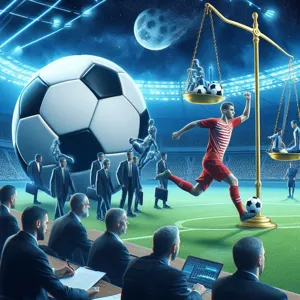In the vibrant world of PC gaming, where immersive narratives and breathtaking graphics converge, ethical dilemmas often lurk beneath the surface.
As players embark on epic quests and engage in fierce battles, they’re faced with choices that challenge their moral compass—from the treatment of in-game characters to the implications of microtransactions and online behavior. The gaming community is evolving, and with it comes a growing awareness of the ethical responsibilities that developers, players, and even publishers hold. In this blog post, we will delve into the multifaceted moral landscape of PC gaming, exploring pressing ethical issues, the impact of player choices, and how gamers can advocate for a more responsible industry. Join us as we level up our understanding of ethics in gaming, empowering ourselves not just to play, but to play with purpose.
1. Introduction to Ethics in PC Gaming

In the rapidly evolving world of PC gaming, where advances in technology meet an ever-expanding player base, the conversation surrounding ethics has never been more crucial. As immersive experiences become more lifelike and narratives increasingly complex, the moral implications of game design, community interactions, and player behavior are coming to the forefront. This landscape is not just defined by the games themselves but also by the societal impacts they impose, from issues of representation and inclusivity to the psychological effects of gaming addiction.
Ethics in PC gaming encompasses a myriad of topics, including the responsibilities of developers in creating content that is both engaging and respectful, the role of publishers in maintaining fair practices, and the obligations of players in fostering a positive gaming environment. As players, we are not just passive consumers; we are active participants in a culture that can either uplift or undermine the values we hold dear. From microtransactions and loot boxes that blur the lines of fair play to the representation of diverse characters and narratives, the decisions made by those within the industry can significantly influence the gaming experience.
As we delve deeper into this moral landscape, it becomes clear that navigating ethics in PC gaming is a collective responsibility. Developers, players, and communities must engage in thoughtful discourse about what it means to create and enjoy games that reflect our values and ethics. This introduction sets the stage for a broader exploration of the ethical dilemmas faced in the gaming industry today, encouraging readers to reflect on their roles as consumers and advocates for change in this vibrant and dynamic sphere.
2. The Evolution of Ethics in Gaming Culture
The evolution of ethics in gaming culture is a fascinating journey that reflects broader societal changes and the growing complexity of the digital landscape. In the early days of gaming, ethics were largely defined by straightforward rules of gameplay and a limited understanding of the impact games could have on players. As technology advanced and the gaming community expanded, so too did the ethical considerations surrounding the industry.
Initially, most discussions centered around the content of games—issues such as violence, representation, and the portrayal of gender and race. Controversies surrounding titles that glorified violence or perpetuated harmful stereotypes sparked debates about the moral responsibilities of developers. As the medium matured, gamers began to recognize their own ethical responsibilities, advocating for inclusivity and diversity both in the games themselves and within the gaming community.
Today, the discourse has evolved to encompass a wider range of issues. Microtransactions, loot boxes, and pay-to-win models have raised questions about fairness and consumer rights, particularly regarding vulnerable populations such as minors. Moreover, the rise of online multiplayer games has brought issues of player conduct, harassment, and toxicity to the forefront, prompting calls for more robust community guidelines and accountability mechanisms.
As gaming continues to intersect with real-world issues—such as mental health, social justice, and environmental sustainability—the call for ethical practices has never been more pressing. Developers and players alike are now engaging in thoughtful conversations about how games can be designed not only for entertainment but also as tools for empathy, education, and positive social change. This ongoing evolution reflects a growing recognition that gaming is not just a pastime; it’s a powerful cultural force that shapes values, behaviors, and societal norms. Navigating this moral landscape requires a commitment to self-reflection, dialogue, and an unwavering dedication to fostering an inclusive and respectful community.
3. Understanding Moral Choices in Video Games

Understanding moral choices in video games is essential for players who wish to engage with gaming on a deeper level. Unlike traditional forms of storytelling, video games offer a unique platform where players are not merely passive observers but active participants in the narrative. This interactivity allows gamers to face ethical dilemmas that often reflect complex real-world issues, prompting them to consider the consequences of their actions in a virtual space.
From the moment players enter a game, they are often confronted with choices that can affect the storyline, the fate of characters, and even the game world itself. Whether it’s deciding whether to spare an enemy or to steal from a struggling NPC, these moral decisions can evoke feelings of guilt, pride, or even indifference, depending on the player’s values and experiences. Games like “The Witcher” series and “Mass Effect” are notorious for their branching narratives, where every choice can lead to vastly different outcomes, encouraging players to weigh their options carefully.
Moreover, understanding moral choices in video games can foster empathy and critical thinking. By stepping into the shoes of different characters, players are challenged to consider perspectives they may not encounter in their daily lives. This immersive experience can lead to greater awareness of societal issues, such as the impact of war, discrimination, and the struggle for justice.
As the gaming industry continues to evolve, so too does the importance of ethical storytelling. Developers are increasingly recognizing their responsibility to create games that not only entertain but also provoke thought and discussion about morality. For players, this presents an opportunity to reflect on their own values and the implications of their choices, both within the game and in the broader context of society. In this way, understanding moral choices in video games becomes not just a gameplay mechanic, but a vital part of the gaming experience that can lead to personal growth and a deeper understanding of the human condition.
4. The Role of Game Developers in Ethical Design
In the fast-evolving world of PC gaming, the responsibility of ethical design increasingly falls on the shoulders of game developers. These creators wield immense power, not just in crafting immersive experiences, but in shaping the moral framework of the gaming landscape. As the audience grows more discerning, developers are called to reflect on how their choices—ranging from in-game monetization strategies to narrative content—impact players and the wider community.
At the core of ethical design lies the principle of respect for the player. Developers have a duty to prioritize transparency, ensuring that players are fully aware of what they are purchasing and the implications of their choices. This includes avoiding exploitative practices, such as aggressive microtransactions that can prey on vulnerable players or obscure loot box mechanics that blur the lines between gaming and gambling. By providing clear information and fair pricing models, developers not only foster trust but also cultivate a loyal player base.
Moreover, the narratives and themes woven into games play a crucial role in ethical design. Developers should be mindful of the stories they choose to tell and the representation of characters within those narratives. Engaging with diverse perspectives and avoiding harmful stereotypes can create a more inclusive environment that resonates with a broader audience. Games have the potential to challenge societal norms and provoke thought, and developers can contribute positively by crafting stories that reflect a variety of experiences and promote empathy.
Additionally, developers must consider the potential long-term effects of their creations. Games have the power to influence behaviors, attitudes, and even social dynamics. By consciously integrating ethical considerations into their design processes—whether through promoting cooperation over competition, fostering positive community interactions, or encouraging critical thinking—developers can help shape a healthier gaming culture.
Ultimately, the role of game developers in ethical design is not just a professional obligation but a moral imperative. By embracing this responsibility, they can elevate the gaming experience, ensuring that it remains not only a source of entertainment but also a platform for positive change. As players become more aware and vocal about their expectations, developers who prioritize ethical design will not only stand out in a crowded market but also play a pivotal role in navigating the moral landscape of PC gaming.
5. Representation and Diversity in Gaming Narratives

Representation and diversity in gaming narratives have become pivotal elements in shaping the moral landscape of the industry. As gaming continues to evolve beyond mere entertainment, it reflects and influences societal values, making it essential for developers to embrace a more inclusive approach. Historically, many games have leaned on stereotypes or offered a narrow view of different cultures, genders, and identities. However, as the gaming community grows increasingly diverse, players demand richer, more nuanced stories that resonate with a broader audience.
Incorporating diverse characters and narratives not only enriches gameplay but also fosters empathy and understanding among players. When gamers encounter protagonists and side characters from various backgrounds—whether it’s through race, gender, sexual orientation, or ability—they are invited to explore new perspectives and experiences. This deeper engagement can challenge preconceived notions and encourage discussions around important societal issues, such as representation, privilege, and the impact of systemic inequality.
Moreover, the gaming industry is witnessing an inspiring shift as developers prioritize inclusive storytelling. Titles like “The Last of Us Part II,” “Life is Strange,” and “Celeste” exemplify how diverse narratives can be woven seamlessly into gameplay, making them not just a token addition but a fundamental aspect of the story. These games not only reflect the realities of marginalized communities but also empower players to confront their own biases and assumptions.
As players, it’s crucial to support and advocate for games that prioritize representation and diversity. By choosing to engage with titles that challenge the status quo, gamers contribute to a more ethical and inclusive gaming culture. The push for diverse narratives is not merely a trend; it’s an essential step toward creating an environment where everyone feels seen, heard, and valued within the digital landscape. As we navigate the moral complexities of gaming, embracing representation can lead to a richer, more meaningful experience for all players.
6. Microtransactions and Their Ethical Implications
Microtransactions have become a pervasive feature in the landscape of PC gaming, transforming how developers monetize their creations and how players engage with them. While the allure of acquiring new skins, characters, or in-game currency can enhance the gaming experience, it raises significant ethical questions about fairness, accessibility, and player autonomy.
At their core, microtransactions often blur the line between optional purchases and essential gameplay elements. Players may find themselves at a disadvantage in competitive environments if they choose not to spend extra money, leading to a phenomenon known as “pay-to-win.” This practice can create an uneven playing field, where those who can afford to spend more achieve greater success, potentially alienating dedicated players who prefer to earn their rewards through skill and perseverance.
Moreover, the psychological implications of microtransactions cannot be overlooked. Many games employ tactics such as loot boxes or limited-time offers, which exploit the principles of scarcity and reward to encourage impulsive spending. This can lead to a cycle of compulsive purchasing, particularly among younger audiences who may lack the financial literacy to make informed decisions. As developers tap into these behavioral triggers, questions arise about their responsibility to protect players from exploitation.
In addition, the impact of microtransactions on game design itself is profound. Some developers may prioritize monetization over the overall quality of the game, crafting experiences that feel more like marketing vehicles than immersive narratives. This shift can result in shallow gameplay, where the focus is less on storytelling and more on enticing players to open their wallets.
As consumers become more aware of these issues, the conversation surrounding microtransactions is evolving. Players are increasingly demanding transparency and ethical practices from developers, advocating for systems that respect their time and investment. In this moral landscape, the challenge lies in finding a balance between sustainable business models and a commitment to providing fair and enjoyable gaming experiences for all. The ongoing dialogue surrounding microtransactions will undoubtedly shape the future of PC gaming, as both players and developers navigate these complex ethical waters together.
7. Online Gaming Communities: A Double-Edged Sword

Online gaming communities are a double-edged sword, offering both incredible opportunities for connection and collaboration, as well as a breeding ground for toxicity and division. On one side, these virtual spaces allow gamers from around the globe to come together, sharing their passion for games, strategizing, and forming friendships that transcend geographical boundaries. Whether through forums, Discord servers, or social media groups, players can exchange tips, celebrate achievements, or simply enjoy casual banter, creating a sense of belonging that enhances the gaming experience.
However, this sense of community can quickly turn sour. The anonymity of online interactions sometimes leads to negative behaviors, including trolling, harassment, and gatekeeping. Newcomers to a game can feel overwhelmed and unwelcome, often discouraged from participating due to the hostility they encounter. Additionally, echo chambers can form within these communities, where harmful ideologies flourish unchallenged, fostering an environment where exclusion and discrimination become normalized.
Navigating this complex moral landscape requires a proactive approach from both the gaming community and developers. Encouraging positive interactions through moderation, promoting inclusivity, and providing platforms for marginalized voices can help cultivate healthier environments. Players must also take personal responsibility, choosing to uplift others and challenge negative behaviors within their circles. By striking a balance between the benefits of community and addressing its pitfalls, the gaming world can evolve into a space that not only entertains but also fosters ethical engagement and mutual respect.
8. The Impact of Violence and Content on Players
The impact of violence and content on players in the realm of PC gaming is a multifaceted issue that has sparked extensive debate among developers, players, and industry experts alike. Video games, particularly those with violent themes, often serve as a reflection of societal norms and issues, but they also raise critical questions about the psychological effects on players.
Research suggests that exposure to violent content can desensitize individuals, potentially altering their perceptions of aggression and conflict. For some players, these virtual experiences might blur the lines between fantasy and reality, leading to a diminished response to real-world violence. This phenomenon is especially concerning for younger audiences, who may be more impressionable and susceptible to the influences of gaming narratives.
However, it’s essential to recognize that not all players will react the same way to violent content. Many gamers can separate fiction from reality, enjoying the thrill of a first-person shooter while maintaining their moral compass in everyday life. This divergence in responses underscores the need for a nuanced understanding of player psychology and the responsibility of developers to consider the implications of their content.
Moreover, the conversation around violent gaming often intersects with broader societal issues, such as mental health and community behavior. As the gaming community becomes more diverse and inclusive, there’s a growing call for games that promote empathy, cooperation, and positive social interactions. Developers are increasingly challenged to create experiences that not only entertain but also contribute positively to players’ moral frameworks.
In this evolving landscape, it becomes crucial for both gamers and creators to engage in dialogues about the ethics of game content. By navigating these discussions thoughtfully, the industry can foster a gaming culture that prioritizes well-being while still embracing the excitement and creativity that makes gaming such a beloved pastime. Ultimately, the impact of violence and content on players is a reflection of our values and choices, and it is up to both developers and the community to shape a future that balances enjoyment with ethical responsibility.
9. Navigating Toxicity: Creating a Positive Gaming Environment
In the ever-evolving landscape of PC gaming, one of the most pressing challenges is the pervasive toxicity that can mar the experience for players. While the digital realm offers vast opportunities for connection, collaboration, and competition, it can also become a breeding ground for harassment, discrimination, and unsportsmanlike conduct. As responsible gamers and community leaders, it’s crucial to take proactive steps to foster a more inclusive and positive gaming environment.
Creating a positive gaming atmosphere starts with setting clear expectations for behavior among your peers and within your gaming community. This can be accomplished by establishing and promoting a code of conduct that emphasizes respect, empathy, and support. Encourage players to communicate openly about their experiences and feelings, and provide safe channels for reporting negative behavior without fear of retaliation. This fosters a culture of accountability, where everyone feels empowered to contribute to a healthier community.
Additionally, consider implementing moderation tools and features that help manage toxic interactions. Many popular games and platforms offer options for muting, blocking, or reporting players who engage in harmful behavior. By utilizing these tools and encouraging others to do the same, you create a collective commitment to discouraging toxicity.
Education also plays a pivotal role in navigating toxicity. Host forums, workshops, or discussions that address the impact of negative behavior and the importance of inclusivity. Invite diverse voices to share their experiences and insights, creating a richer understanding of the challenges faced by marginalized groups within the gaming world.
Finally, remember that positivity breeds positivity. Celebrate achievements—both big and small—of your fellow gamers. Whether through shout-outs in community chats or recognition on social media, highlighting positive contributions can inspire others to follow suit. By championing kindness and collaboration, you help to set a powerful example that resonates throughout the gaming community.
Navigating toxicity is not merely about addressing bad behavior; it’s about actively cultivating a culture where everyone feels valued and included. By taking these steps, we can transform the gaming landscape into a welcoming space that encourages creativity, connection, and respect for all players. Together, let’s level up not just our skills, but also our commitment to ethics in gaming.
10. Environmental Considerations in Game Production
As the gaming industry continues to thrive, it’s essential to recognize the environmental implications of game production. From the manufacturing of physical copies to the energy consumption of servers running online games, every step in the creation and distribution process can leave a significant carbon footprint. This is especially true as gamers demand higher graphics fidelity and expansive worlds, which require more powerful hardware and, consequently, greater energy consumption.
Developers and publishers are beginning to acknowledge their responsibility towards the planet. Many are now prioritizing sustainable practices, such as using recycled materials for packaging, reducing waste in production, and ensuring that their supply chains adhere to environmentally friendly standards. For instance, some companies have committed to carbon neutrality by investing in renewable energy sources or participating in reforestation projects.
Additionally, digital distribution is becoming more prevalent, minimizing the need for physical materials and reducing transportation emissions. However, even digital games have an environmental cost, as the servers that host these games consume vast amounts of energy. This has led to a surge in interest around “green gaming,” where developers seek to minimize their energy usage and environmental impact.
Gamers, too, can play a role in this ethical landscape by supporting companies that prioritize sustainability and by being mindful of their own energy consumption. This includes advocating for energy-efficient gaming setups, being conscious about playing habits, and even recycling old gaming equipment rather than letting it end up in landfills.
In an era where climate change is at the forefront of global conversations, the gaming community must ensure that the joy of gaming doesn’t come at the expense of our planet. By embracing environmental considerations in game production, we can create a gaming landscape that is not only engaging but also responsible and sustainable for generations to come.
11. The Influence of Gamification on Ethical Decision-Making
Gamification has become a powerful tool in the world of PC gaming, shaping not only how players engage with their favorite titles but also how they navigate complex ethical dilemmas within those games. By integrating game mechanics—such as point scoring, leaderboards, and rewards—into gameplay, developers create an environment that incentivizes players to make choices that can significantly impact their in-game success and the overall narrative. However, this captivating element also introduces a fascinating question: how does gamification influence ethical decision-making?
As players immerse themselves in richly developed storylines, they often encounter scenarios that require them to weigh moral choices against tangible rewards. For instance, a player might find themselves at a crossroads, faced with the decision to aid an NPC in distress or to pursue a more self-serving path that offers better loot. The immediate gratification of rewards can cloud judgment, leading players to prioritize short-term gains over the long-term consequences of their actions. This creates a unique tension where ethical considerations are juxtaposed with gameplay mechanics, forcing players to reflect on their values within a virtual space.
Moreover, the effects of gamification extend beyond individual gameplay experiences. Many games utilize leaderboards and achievements that promote competition among players, often leading to a culture where winning at all costs can overshadow ethical concerns. This competitive environment can normalize aggressive tactics, including cheating or exploiting game mechanics, further complicating the moral landscape. As players strive to climb the ranks, they may rationalize unethical behavior to achieve their goals, raising important questions about integrity in both the digital and real worlds.
However, not all gamification is detrimental to ethical decision-making. Some games purposely design mechanics that encourage empathy and cooperation among players. Titles like *Journey* or *It Takes Two* foster collaboration and emotional connections, guiding players toward more altruistic choices. In these instances, gamification serves as a catalyst for positive moral behavior, demonstrating that the way a game is structured can significantly impact the ethical framework it encourages.
As the gaming industry continues to evolve, understanding the influence of gamification on ethical decision-making becomes increasingly crucial. Developers hold a responsibility to create experiences that not only entertain but also challenge players to engage with complex moral questions. By navigating this moral landscape thoughtfully, both players and developers can harness the power of gamification to promote ethical behavior, ultimately enriching the gaming experience while fostering a more conscientious community.
12. Balancing Freedom of Expression and Accountability
In the vibrant and often contentious world of PC gaming, the debate surrounding freedom of expression and accountability is becoming increasingly nuanced. On one hand, gaming provides a unique platform for creativity, allowing developers and players alike to express their ideas, narratives, and experiences in ways that challenge conventional norms. Games have often served as a medium for social commentary, pushing boundaries and fostering discussions around topics like identity, politics, and ethics. However, this freedom can sometimes come at a cost, as the line between artistic expression and harmful content can become blurred.
As players, developers, and publishers navigate this moral landscape, it is essential to recognize that freedom of expression does not exist in a vacuum. Just as creators have the right to share their visions, they also bear a responsibility to consider the impact of their work on diverse audiences. The rise of online gaming communities has amplified both the voices of marginalized groups and the potential for toxic behavior. In this environment, accountability becomes crucial; developers must be prepared to address the consequences of their narratives and the cultures fostered by their games.
Finding a balance between these two forces is no easy feat. Developers are increasingly faced with questions about how to include sensitive topics without perpetuating harmful stereotypes or inciting hate. Meanwhile, players must grapple with the reality that their voices can shape the gaming landscape, wielding both the power to uplift and the potential to harm.
To navigate this tricky terrain, open dialogue and transparency are key. Engaging with players, listening to feedback, and fostering an inclusive community can lead to more ethically responsible gaming experiences. By prioritizing both freedom of expression and accountability, the gaming industry can create an environment that celebrates creativity while being mindful of its wider social implications. This balance not only enriches the gaming experience but also contributes to a more respectful and inclusive community, where all players feel valued and heard.
13. Case Studies: Games that Challenge Ethical Norms
In the ever-evolving world of PC gaming, certain titles stand out not just for their gameplay mechanics or stunning graphics but for the moral dilemmas they present to players. These games often force players to confront uncomfortable questions about ethics, societal norms, and personal values, challenging them to navigate complex moral landscapes.
One poignant example is *Spec Ops: The Line*, a military shooter that subverts traditional genre expectations. At first glance, it presents itself as a typical action game, but as the narrative unfolds, players are faced with harrowing decisions that question the very nature of heroism and the consequences of violence. The game leads players through a morally ambiguous journey, culminating in moments that force them to reconsider their actions and the impact of those decisions on both their character and the world they inhabit.
Another compelling case study is *The Stanley Parable*, a game that plays with narrative structure and player agency. It challenges the notion of free will in gaming, inviting players to reflect on their choices and the implications of following or defying the narrator’s instructions. This meta-commentary on choice and consequence encourages players to contemplate the ethics of their actions within the game and, by extension, in real life.
In the realm of horror, *Until Dawn* provides a gripping exploration of morality through its branching narrative paths. Players must make decisions that determine the fate of the characters, often choosing between self-preservation and altruism. The game delves into themes of trust, betrayal, and the often-blurred line between right and wrong, forcing players to grapple with their instincts in life-or-death scenarios.
These case studies illustrate how video games can serve as a powerful medium for exploring ethical dilemmas. By engaging players in challenging narratives and morally complex situations, they foster deeper reflections on personal ethics and societal values. As we continue to navigate the moral landscape of gaming, it’s essential to recognize the capacity of these narratives to provoke thought and inspire dialogue about the ethical implications of our choices—not just in the virtual realm, but in the world around us.
14. How Players Can Advocate for Ethical Practices
In the ever-evolving realm of PC gaming, where immersive experiences and technological advancements abound, players wield more power than they often realize. As consumers and enthusiasts, gamers have a unique opportunity to advocate for ethical practices within the industry. This advocacy can take many forms, each playing a vital role in shaping a more responsible gaming landscape.
One of the most effective ways players can make their voices heard is through informed purchasing decisions. By supporting developers and publishers that prioritize ethical practices—such as fair labor conditions, transparent business models, and inclusive game design—players can send a strong message about the kind of industry they want to see. Engaging with games that promote positive social messages, or that are developed by studios known for their ethical commitments, reinforces the demand for integrity in gaming.
Beyond buying choices, players can leverage the power of community. Online forums, social media platforms, and dedicated gaming communities provide spaces for discussions about ethical practices in gaming. By sharing knowledge, raising awareness about problematic practices, and highlighting exemplary companies, players can foster a culture of accountability. Initiatives like boycotting games from companies that exploit workers or employ predatory monetization strategies can create significant pressure for change.
Additionally, players can advocate for ethical practices by participating in surveys, beta tests, and feedback sessions offered by developers. Providing constructive criticism can help shape game design and production practices that align with players’ values. Many companies are eager to listen to their audience to build loyalty and enhance player satisfaction. Using these platforms to voice concerns about microtransactions, loot boxes, or representation in games can lead to more responsible decisions by developers.
Lastly, supporting and contributing to organizations that promote ethics in gaming—either through donations or volunteer work—can amplify the impact of individual efforts. These organizations often work to push for better policies in the industry, advocate for marginalized voices, and establish guidelines for ethical game development.
In essence, players hold significant influence in the moral landscape of PC gaming. By making conscious choices, engaging in community discussions, providing feedback, and supporting ethical initiatives, they can advocate for a gaming culture that prioritizes integrity, inclusivity, and respect. In doing so, gamers not only enhance their own experiences but also contribute to a more equitable and responsible industry for future generations.
15. Conclusion: The Future of Ethics in PC Gaming
As we stand at the crossroads of technology and morality, the future of ethics in PC gaming presents both exciting opportunities and daunting challenges. The landscape is evolving rapidly, with advancements in artificial intelligence, virtual reality, and online connectivity reshaping the way we experience games. These innovations not only enhance gameplay but also raise ethical questions that demand our attention.
Developers are now more than ever aware of the impact their creations have on players and society at large. As discussions around inclusivity, representation, and mental health become increasingly prominent within the gaming community, the industry is beginning to respond. We can anticipate a future where game narratives are more thoughtful, diverse, and reflective of the complexities of real-world issues. This shift is a promising sign that ethical considerations will play a pivotal role in game development moving forward.
Moreover, the rise of community-driven platforms and the influence of player feedback are shifting the power dynamics, compelling developers to prioritize ethical practices and transparency. Gamers are becoming activists in their own right, advocating for responsible monetization strategies, fair treatment of developers, and a rejection of toxic behavior. This collective voice has the potential to hold companies accountable and foster a healthier gaming environment.
However, challenges remain. As the gaming industry continues to grow, so too does the risk of exploitative practices, such as predatory monetization schemes and the spread of harmful content. It will be crucial for stakeholders—including developers, publishers, and players—to engage in ongoing conversations about ethics, ensuring that the core values of respect, fairness, and compassion are woven into the very fabric of gaming culture.
In conclusion, the future of ethics in PC gaming is a collaborative journey. By collectively fostering an environment where ethical considerations are prioritized, we can ensure that gaming not only entertains but also enriches our lives and our communities. The choices we make today will shape the gaming landscape of tomorrow, leading to a world where games can inspire, educate, and unite us in our shared humanity. Let’s embrace this opportunity to level up not just our skills in gaming, but the very ethics that guide the industry.
In conclusion, navigating the moral landscape of PC gaming is an ongoing journey that requires vigilance, introspection, and a commitment to ethical standards. As players, developers, and stakeholders in the gaming community, we all share a responsibility to foster an environment that prioritizes respect, inclusivity, and social awareness. By engaging critically with the content we consume and create, we can elevate our gaming experiences and advocate for positive change within the industry. Remember, ethical gaming is not just about individual choices; it’s about shaping a culture that values integrity and accountability. Let’s continue to level up our ethics and ensure that the virtual worlds we inhabit reflect the best of our values. Thank you for joining us on this important exploration, and we look forward to hearing your thoughts and experiences as we collectively push the boundaries of what gaming can truly be.
















